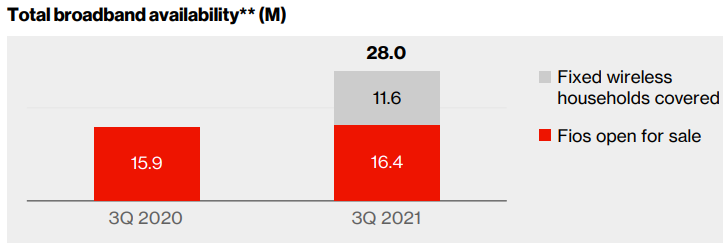Fixed wireless has been touted as a possible strategic enabler in the U.S. home broadband business, and it does now appear deployments at scale, with customer gains large enough to note on earnings calls, has begun. Verizon and T-Mobile are the leading firms to watch, as both firms have the most to gain from widespread fixed wireless deployments.
The implications for the home broadband market are highly significant. T-Mobile has had zero share of that market, while Verizon has been sharply limited by its limited footprint outside its New England and Mid-Atlantic states focus.
Since the U.S. home broadband market is nearly saturated, most account gains by any provider will come at the expense of an existing provider. That, in turn, is important because fixed wireless is one platform telcos can use to reverse a 20-year pattern of cable operators leading in installed base and market share.
In addtion to stepped-up fiber-to-home activity, fixed wireless is a primary tool that could change the U.S. home broadband installed base from a 70 percent cable lead to a more-balanced 50-50 market, with cable and telcos each eventually holding about half the installed base share.
Since home broadband now is the foundation service for any fixed network services provider, such a shift would be highly significant.
Verizon now says it will pass 15 million homes with its fixed wireless services, using both 4G and 5G, while total fixed wireless accounts at the end of the third quarter 2021 were 150,000, of which 55,000 were added in the third quarter alone.
In the past Verizon has talked about a fixed wireless footprint of about 50 million homes as a planned-for goal as the C-band assets are turned up, possibly by the end of 2021.
Most of that coverage will occur in areas outside the Verizon fixed network territory. At the moment, about half the Verizon fixed wireless customers represent new accounts, while half are existing Verizon customers.
“I would say, there are probably, roughly, half and half,” said Hans Vestberg, Verizon CEO. “Half meaning coming from our existing base and half we're taking from other suppliers.”
Significantly, Verizon also reports that fixed wireless average revenue per user is “similar” to a mobility account. That suggests that most of the installed base is on 4G or lower-speed 5G at the moment, and also suggestive of pricing suggesting that most customers also use Verizon for mobility service ($40 a month for Verizon mobility customers, $60 for non-customers).
Some of us would expect ARPU to begin climbing as more of the customer base adds services using millimeter wave and mid-band spectrum. The pricing for those plans runs from $50 a month (Verizon mobility customers) up to $70 a month (non-mobile subscribers).
As will be the case for 5G generally, Verizon fixed wireless might come in three flavors. Some customers might only be able to buy 4G versions, which are the most speed-constrained, and generally topping out somewhere between 25 Mbps and 50 Mbps.
Most customers will be able to buy mid-band 5G fixed wireless, which likely will be able to support the 100 Mbps to 200 Mbps services most households buy at the moment. Some lesser percentage of locations will be able to buy the wireline-equivalent millimeter wave services operating up to a gigabit per second or so.
Over the last year, though the fiber-to-home footprint grew by 500,000 locations, the fixed wireless footprint added 11.6 million locations.
In fact, fixed wireless now accounts for about 41 percent of Verizon’s home broadband passings.

source: Verizon
It remains to be seen how many customer accounts will be driven by fixed wireless, to be sure. In the past, many observers have suggested fixed wireless suppliers can get take rates in the 15 percent to 20 percent range.
In a saturated market, those gains largely represent market share taken from another supplier. So the market share implications are quite significant, representing a change between 30 percent to 40 percent in overall share.
The expansion of millimeter radio and C-band radio assets will be important. Roughly half the U.S. home broadband base has been content to buy service in the 100 Mbps to 200 Mbps range.
C-band will help boost fixed wireless into those ranges, while millimeter wave will enable speeds approaching the top tier of consumer demand (gigabit service).
Such lower-speed home broadband might appeal to customers content to purchase service operating at the lower ranges of bandwidths at or below 50 Mbps. That still represents 10.5 percent of the market, according to Openvault.
Notably, the third quarter 2021 earnings report was the first ever when Verizon actually began reporting fixed wireless subscriber growth. That is normally an indication that a firm believes it has an attractive story to tell, with volume growth expected.
To my knowledge, T-Mobile has not reported its fixed wireless account figures. In light of Verizon's reporting, T-Mobile might soon have to respond.

